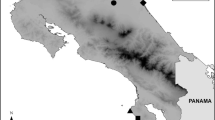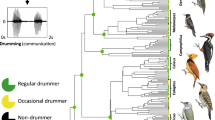Abstract
The analysis of mechanisms of how populations differentiate and new species arise is fundamental for understanding the evolution of biological diversity. Mating preferences and sexually selected characters can rapidly diverge between populations, and this can probably lead to premating reproductive isolation and hence the evolution of new species. We have investigated the role of a complex bidirectional acoustic communication system for the radiation of grasshoppers of the subfamily Gomphocerinae. Species are characterized by species-specific songs, which result from complex stridulatory movement patterns of both hind legs. A molecular phylogeny indicates that within the genera Chorthippus and Stenobothrus several species-rich taxa diverged recently and thus represent independent radiations. Divergence in allopatry and hybridization after secondary contact are two mechanisms that led to new song types and female preferences and thus may have contributed to rapid speciation by the evolution of premating reproductive isolation.
Access this chapter
Tax calculation will be finalised at checkout
Purchases are for personal use only
Similar content being viewed by others
References
Alexander RD (1960) Sound communication in Orthoptera and Cicadidae. In: Lanyon WE, Travolga WN (eds) Animal sounds and communication. American Institute of Biological Sciences, Washington, pp 38–92
Berger D (2008) The evolution of complex courtship songs in the genus Stenobothrus Fischer, 1853 (Orthoptera, Caelifera, Gomphocerinae). PhD Thesis, Friedrich-Alexander-Universität Erlangen-Nürnberg, Erlangen
Berger D, Chobanov DP, Mayer F (2010) Interglacial refugia and range shifts of the alpine grasshopper Stenobothrus cotticus (Orthoptera: Acrididae: Gomphocerinae). Org Div Evol 10:123–133
Bukhvalova MA, Zhantiev RD (1993) Acoustic signals in grasshopper communities (Orthoptera, Acrididae, Gomphocerinae). Zool Zh 72:47–62
Butlin R, Hewitt GM (1985a) A hybrid zone between Chorthippus parallelus parallelus and Chorthippus parallelus erythropus (Orthoptera: Acrididae): morphological and electrophoretic characters. Biol J Linn Soc 26:269–285
Butlin RK, Hewitt GM (1985b) A hybrid zone between Chorthippus parallelus parallelus and Chorthippus parallelus erythropus (Orthoptera: Acrididae): behavioural characters. Biol J Linn Soc 26:287–299
Coyne JA, Orr HA (2004) Speciation. Sinauer, Sunderland
Elsner N (1974) Neuroethology of sound production in gomphocerine grasshoppers (Orthoptera: Acrididae) I. Song patterns and stridulatory movements. J Comp Physiol 88:67–102
Elsner N (1983) A neuroethological approach to the phylogeny of leg stridulation in gomphocerine grasshoppers. In: Huber F, Markl H (eds) Neuroethology and behavioural physiology. Springer, Berlin, pp 54–68
Elsner N, Popov AV (1978) Neuroethology of acoustic communication. Adv Insect Physiol 13:229–355
Ewing AW (1984) Acoustic signals in insect sexual behaviour. In: Lewis T (ed) Insect communication 12th symposium of the Royal Entomological Society of London. Academic, London, pp 223–240
Faber A (1953) Laut- und Gebärdensprache bei Insekten (Orthoptera). Mitt Staatl Mus Nat Stuttgart:1–198
Gottsberger B (2007) Interspecific hybridization between the grasshoppers Chorthippus biguttulus and C. brunneus (Acrididae; Gomphocerinae). PhD Thesis, Friedrich-Alexander-Universität Erlangen-Nürnberg, Erlangen
Gottsberger B, Mayer F (2007) Behavioral sterility of hybrid males in acoustically communicating grasshoppers (Acrididae, Gomphocerinae). J Comp Physiol 193:703–714
Harz K (1975) Die orthopteren europas II. Junk, The Hague
Heller KG, Korsunovskaya O, Ragge DR, Vedenina V, Willemse F, Zhantiev RD, Frantsevich L (1998) Check-list of European Orthoptera. Articulata 7:1–61
Hewitt GM (1999) Post-glacial re-colonization of European biota. Biol J Linn Soc 68:87–112
Jacobs W (1953) Verhaltensbiologische Studien an Feldheuschrecken. Z Tierpsychol 1:1–228
Klappert K, Reinhold K (2003) Acoustic preference functions and sexual selection on the male calling song in the grasshopper Chorthippus biguttulus. Anim Behav 65:225–233
Kriegbaum H (1989) Female choice in the grasshopper Chorthippus biguttulus. Mating success is related to song characteristics of the male. Naturwissenschaften 76:81–82
Kriegbaum H, von Helversen O (1992) Influence of male songs on female mating behavior in the grasshopper Chorthippus biguttulus (Orthoptera: Acrididae). Ethology 91:248–254
Mason DJ, Butlin RK, Gacesa P (1995) An unusual mitochondrial DNA polymorphism in the Chorthippus biguttulus species group (Orthoptera: Acrididae). Mol Ecol 4:121–126
Otte D (1970) A comparative study of communicative behaviour in grasshoppers. Misc Publ Mus Zool Univ Mich 141:1–168
Otte D (1974) Effects and functions in the evolution of signaling systems. Annu Rev Entomol 5:385–417
Perdeck AC (1958) The isolating value of specific song patterns in two sibling species of grasshoppers (Chorthippus brunneus Thunb. and C. biguttulus L.). Behav 12:1–75
Ragge DR, Reynolds WJ (1998) The songs of the grasshoppers and crickets of Western Europe. Harley, Colchester
Ragge DR, Reynolds WJ, Willemse F (1990) The songs of the European grasshoppers of the Chorthippus biguttulus group in relation to their taxonomy, speciation and biogeography (Orthoptera: Acrididae). Bol Sanidad Vegetal (Fuera de serie) 20:239–245
Ramme W (1951) Zur Systematik, Faunistik und Biologie der Orthopteren von Südost- Europa und Vorderasien. Mitt Zool Mus Berlin 27:1–431
Ritchie MG (2007) Sexual selection and speciation. Annu Rev Ecol Evol Syst 38:79–102
Safi K, Heinzle J, Reinhold K (2006) Species recognition influences female mate preferences in the common European grasshopper (Chorthippus biguttulus Linnaeus, 1758). Ethology 112:1225–1230
Saldamando CI, Miyaguchi S, Tatsuta H, Kishino H, Bridle JR, Butlin RK (2005a) Inheritance of song and stridulatory peg number divergence between Chorthippus brunneus and C. jacobsi, two naturally hybridizing grasshopper species (Orthoptera: Acrididae). J Evol Biol 18:703–712
Saldamando CI, Tatsuta H, Butlin RK (2005b) Hybrids between Chorthippus brunneus and C. jacobsi (Orthoptera: Acrididae) do not show endogenous postzygotic isolation. Biol J Linn Soc 84:195–203
Schluter D (2000) The ecology of adaptive Radiation. Oxford University Press, Oxford
Snook RR, Chapman T, More PJ, Wedell N, Crudgington HS (2009) Interactions between the sexes: new perspectives on sexual selection and reproductive isolation. Evol Ecol 23:71–91
Stumpner A, von Helversen O (1994) Song production and song recognition in a group of sibling grasshopper species (Chorthippus dorsatus, Ch. dichrous and Ch. loratus: Orthoptera, Acrididae). Bioacoustics 6:1–23
Taberlet P, Fumagalli L, Wust-Sauc AG, Cosson JF (1998) Comparative phylogeography and postglacial colonization routes in Europe. Mol Ecol 7:453–464
Vedenina VY, von Helversen O (2003) Complex courtship in a bimodal grasshopper hybrid zone. Behav Ecol Sociobiol 54:44–54
Vedenina VY, Panyutin AK, von Helversen O (2007) The unusual inheritance pattern of the courtship songs in closely related grasshopper species of the Chorthippus albomarginatus-group (Orthoptera: Gomphocerinae). J Evol Biol 20:260–277
von Helversen D (1972) Gesang des Männchens und Lautschema des Weibchens bei der Feldheuschrecke Chorthippus biguttulus (Orthoptera, Acrididae). J Comp Physiol 81:381–422
von Helversen D (1997) Acoustic communication and orientation in grasshoppers. In: Lehrer M (ed) Orientation and communication in arthropods. Birkhäuser, Basel, pp 301–341
von Helversen D, von Helversen O (1975a) Verhaltensgenetische Untersuchungen am akustischen Kommunikationssystem der Feldheuschrecken (Orthoptera, Acrididae) I. Der Gesang von Artbastarden zwischen Chorthippus biguttulus und Ch. mollis. J Comp Physiol 104:273–299
von Helversen D, von Helversen O (1975b) Verhaltensgenetische Untersuchungen am akustischen Kommunikationssystem der Feldheuschrecken (Orthoptera, Acrididae). II. Das Lautschema von Artbastarden zwischen Chorthippus biguttulus und Ch. mollis. J Comp Physiol 104:301–323
von Helversen D, von Helversen O (1997) Recognition of sex in the acoustic communication of the grasshopper Chorthippus biguttulus (Orthoptera, Acrididae). J Comp Physiol 180:375–386
von Helversen O (1986) Gesang und Balz bei Feldheuschrecken der Chorthippus albomarginatus-Gruppe (Orthoptera: Acrididae). Zool Jahrb Syst 113:319–342
von Helversen O, Elsner N (1977) The stridulatory movements of acridid grasshoppers recorded with an opto-electronic device. J Comp Physiol 122:53–64
von Helversen O, von Helversen D (1983) Species recognition and acoustic localization in acridid grasshoppers: a behavioral approach. In: Huber F, Markl H (eds) Neuroethology and behavioral physiology. Springer, Berlin, pp 95–107
von Helversen O, von Helversen D (1994) Forces driving coevolution of song and song recognition in grasshoppers. Fortschr Zool 39:253–284
Acknowledgements
We thank Jana Ustinova and Klaus-Gerhard Heller for fruitful discussions and important suggestions for the manuscript. The Deutsche Forschungsgemeinschaft (DFG) and the Staedtler-Foundation supported our work financially.
Author information
Authors and Affiliations
Corresponding author
Editor information
Editors and Affiliations
Additional information
We dedicate this chapter to Professor Dr. Otto von Helversen, who studied the evolution of acoustic communication in grasshoppers for more than 30 years and who tragically died during drafting this review.
Rights and permissions
Copyright information
© 2010 Springer-Verlag Berlin Heidelberg
About this chapter
Cite this chapter
Mayer, F., Berger, D., Gottsberger, B., Schulze, W. (2010). Non-Ecological Radiations in Acoustically Communicating Grasshoppers?. In: Glaubrecht, M. (eds) Evolution in Action. Springer, Berlin, Heidelberg. https://doi.org/10.1007/978-3-642-12425-9_21
Download citation
DOI: https://doi.org/10.1007/978-3-642-12425-9_21
Published:
Publisher Name: Springer, Berlin, Heidelberg
Print ISBN: 978-3-642-12424-2
Online ISBN: 978-3-642-12425-9
eBook Packages: Biomedical and Life SciencesBiomedical and Life Sciences (R0)




